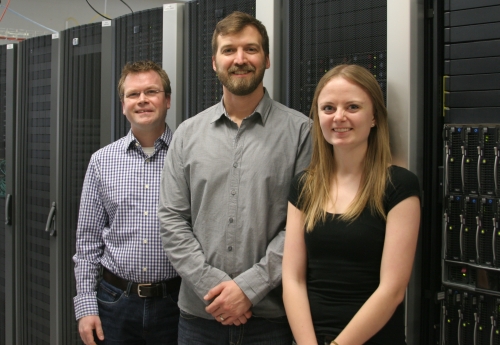Pseudogap theory puts physicists closer to high temperature superconductors

Right to left: Prof. David Hawthorn, Prof. Roger Melko, and Lauren Hayward. They are pictured in front of Waterloo’s SHARCNET supercomputer which they used to perform the calculations.
The theory explains the transition phase to superconductivity, or “pseudogap” phase, which is one of the last obstacles to developing the next generation of superconductors and one of the major unsolved problems of theoretical condensed matter physics.
Their work was published in this week’s issue of the prestigious journal Science.
Superconductivity is the phenomenon where electricity flows with no resistance and no energy loss. Most materials need to be cooled to ultra-low temperatures with liquid helium in order to achieve a superconductive state.
The team includes Professor Roger Melko, Professor David Hawthorn and doctoral student Lauren Hayward from Waterloo’s Physics and Astronomy Department, and Harvard Physics Professor Subir Sachev. Roger Melko also holds a Canada Research Chair in Computational Quantum Many-Body Physics.
“This amazing scientific collaboration actually came about by chance over lunch at the Perimeter Institute between Subir and myself,” said Hawthorn.
Hawthorn showed Sachdev his latest experimental data on a superconducting material made of Copper and the elements Yttrium and Barium. The material, YBa2Cu3O6+x, had an unexplained temperature dependence. Sachdev had a theory but needed expert help with the complex set of calculations to prove it. That’s where Melko and Hayward stepped in and developed the computer code to solve Sachdev’s equations.
Melko and Sachdev already knew each other through Perimeter Institute, where Melko is an associate faculty member and Sachdev is a Distinguished Research Visiting Chair.
“The results all came together in a matter of weeks,” said Melko. “It really speaks to the synergy we have between Waterloo and Perimeter Institute.”
To understand why room-temperature superconductivity has remained so elusive, physicists have turned their sights to the phase that occurs just before superconductivity takes over: the mysterious “pseudogap” phase.
“Understanding the pseudogap is as important as understanding superconductivity itself,” said Melko.
The cuprate, YBa2Cu3O6+x, is one of the few materials known to be superconductive at higher temperatures, but scientists are so far unable to achieve superconductivity in this material above -179°C. This new study found that YBa2Cu3O6+x oscillates between two quantum states during the pseudogap, one of which involves charge-density wave fluctuations. These periodic fluctuations in the distribution of the electrical charges are what destabilize the superconducting state above the critical temperature.
Once the material is cooled below the critical temperature, the strength of these fluctuations falls and the superconductivity state takes over.
Superconducting magnets are currently used in MRI machines and complex particle accelerators, but the cost of cooling materials using Helium makes them very expensive. Materials that achieve superconductivity at a higher temperature could unlock the technology for new smart power grids and advanced power storage units.
The group plans to extend their work both theoretically and experimentally to understand more about the fundamental nature of cuprates.
In just half a century, the University of Waterloo, located at the heart of Canada's technology hub, has become one of Canada's leading comprehensive universities with 35,000 full- and part-time students in undergraduate and graduate programs. Waterloo, as home to the world's largest post-secondary co-operative education program, embraces its connections to the world and encourages enterprising partnerships in learning, research and discovery. In the next decade, the university is committed to building a better future for Canada and the world by championing innovation and collaboration to create solutions relevant to the needs of today and tomorrow. For more information about Waterloo, please visit www.uwaterloo.ca.
-30-
Nick Manning
University of Waterloo
519-888-4451
226-929-7627
www.uwaterloo.ca/news
@uWaterlooNews
Attention broadcasters: Waterloo has facilities to provide broadcast quality audio and video feeds with a double-ender studio. Please contact us to book.
Media Contact
All latest news from the category: Physics and Astronomy
This area deals with the fundamental laws and building blocks of nature and how they interact, the properties and the behavior of matter, and research into space and time and their structures.
innovations-report provides in-depth reports and articles on subjects such as astrophysics, laser technologies, nuclear, quantum, particle and solid-state physics, nanotechnologies, planetary research and findings (Mars, Venus) and developments related to the Hubble Telescope.
Newest articles

Bringing bio-inspired robots to life
Nebraska researcher Eric Markvicka gets NSF CAREER Award to pursue manufacture of novel materials for soft robotics and stretchable electronics. Engineers are increasingly eager to develop robots that mimic the…

Bella moths use poison to attract mates
Scientists are closer to finding out how. Pyrrolizidine alkaloids are as bitter and toxic as they are hard to pronounce. They’re produced by several different types of plants and are…

AI tool creates ‘synthetic’ images of cells
…for enhanced microscopy analysis. Observing individual cells through microscopes can reveal a range of important cell biological phenomena that frequently play a role in human diseases, but the process of…





















